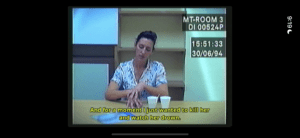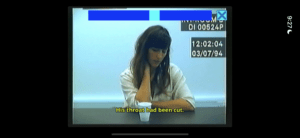For my critical play, I played Her Story created by Sam Barlow. The game was extremely interesting and unique in its structure and how it introduces play. There are no instructions and instead, the user is prompted to press play. Upon pressing play, the opening page was the following screen:

At this point it is unclear how exactly the game is meant to operate. So, I pressed search and arrived at the following screen: 
Upon clicking the videos, I slowly started to piece together that these were short intervals of police interrogations. Once I had watched the four videos, I played around with the buttons before realizing I could enter words in the search bar. As I started to do this, I realized new videos would pop up based on the words I entered, telling more of the story:

This style of introducing play by not presenting any context and rather jumping in straight to the content was very intriguing — I almost felt like it relied on the user learning and practicing interaction loops. The user starts off with a couple videos and the search term “murder.” From watching these videos, we learn that a man named Simon is in question. The character on screen appears to be accused of murdering him or being involved in his murder. This essentially serves as our starting mental model. Then, the user makes a decision of what to search based on the videos just watched — for example, I searched Simon and then applied the action. The “manipulate rules” segment of the interaction loop does not really apply here but the player does receive feedback. New videos could show up, showing that the search term is relevant. Then, the user watches the videos, updates their mental model of the narrative and proceeds. In this way, the structure of the game constantly follows that of an interaction loop. However, each interaction loop was heavily skewed towards receiving content to update mental maps. I noticed that this really affected how fun the game was and made the game feel tedious at times. At the same time, the constant “work” to update the mental model felt exhausting — though the simple format of clicking through videos implies this game may be one of submission, it is definitely a game of challenge.
The narrative structure of this game was so intriguing. As I progressed through the narrative and repeated the process of listening to the video and searching up a term, I learned more about the characters at play including arguments, a secret twin and finally who killed Simon! The narrative itself deserves a lot of credit (and is too long to cover here and also too crazy to explain) but was extremely captivating and complex.



That being said, the structure of the game seemed to rely too heavily on the narrative to the point where I was confused about what aspects made this a game. I didn’t feel like there was an outcome — players just had to watch enough of the videos to understand the case at hand and be prompted by the machine — and the only relevant rule seemed to be that when you searched a word, only the top 5 videos would be viewable but you could see how many videos included that word. I found myself getting bored as I played, and also struggled to keep track of what words to search. Instead, at times, I resorted to searching murder-related words like blood, knife and throat to see if it would get me anywhere. While I understand how piecing these video clips together can be intriguing and fun, the lack of gamification made it hard for me to stay engaged and enjoy it. Especially given that all the “evidence” from the mystery was in the same medium, I found that the game got repetitive with one type of action/interaction loop/


